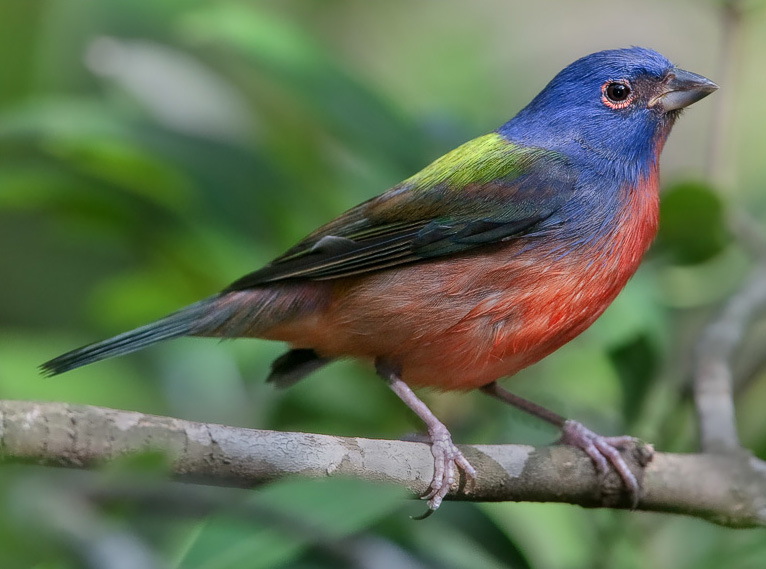Aviculturists in the USA are sometimes surprised to learn that one of the world’s most splendidly-colored birds is a native, and is well established in captivity in other countries. The male Painted Bunting (Passerina ciris), clad in bright blue, vermillion, red, orange and green, rivals any tropical species in beauty.
Range and Status
 Two distinct populations of Painted Buntings range from North Carolina south through Florida to Cuba and other Caribbean islands and from northern Texas to Mexico.
Two distinct populations of Painted Buntings range from North Carolina south through Florida to Cuba and other Caribbean islands and from northern Texas to Mexico.
Protected from capture in the USA, poaching is believed to be a threat to their survival in Mexico. The Audubon Society has documented severe declines in the eastern population as well.
It is not legal to keep painted buntings in the USA, but hands-on work with them is sometimes possible for licensed rehabilitators (please see “Further Reading”, below). These gorgeous relatives of the northern cardinal have, however, long been a favorite in European collections and, to a lesser extent, among Mexican aviculturists.
Husbandry
Painted Buntings are not particularly delicate captives, but are best kept in an outdoor aviary rather than a cage. When provided with a warm shelter, they can overwinter outdoors in as far north as England.
Wild Painting Buntings consume a diet composed nearly equally of insects and other invertebrates and seeds, grains, buds and shoots. Interestingly, they have often been observed to pluck insects from the webs of the huge orb-weaving spiders (Nephila spp.) that occur over much of their range. While captives survive on a seed based diet, variety is required if they are to remain in peak condition.
Maintaining Color
 The plumage of male Painted Buntings typically fades in captivity. The most brilliantly colored specimens that I have seen in zoos have been fed a diet rich in live insects, including wild caught species. The provision of natural sunlight or the use of a UVA-emitting lamp may also help to maintain the colors of the feathers.
The plumage of male Painted Buntings typically fades in captivity. The most brilliantly colored specimens that I have seen in zoos have been fed a diet rich in live insects, including wild caught species. The provision of natural sunlight or the use of a UVA-emitting lamp may also help to maintain the colors of the feathers.
Captive Breeding
Painted Buntings are not “easy” breeders, but a compatible pair that does reproduce will usually be quite consistent. Males are absolutely intolerant of each other – fights between free-living individuals occasionally result in fatalities.
A large, well-planted aviary situated in a quiet location is common to all successful breeders, and a steady supply of live or canned insects is necessary if the young are to be reared successfully.
Further Reading
Although Painted Buntings may not be kept as pets in the USA, people licensed to rehabilitate birds do occasionally have a chance to work with them. The National Association of Wildlife Rehabilitators offers advice to those wishing to become trained and licensed as rehabilitators.
Painted Buntings are in decline, and your observations can be of use in helping to conserve them. Please visit Ebird to learn more and report sightings.
Next time we’ll take a look at some of this bird’s equally colorful relatives.
Painted Bunting (male) image referenced from wikipedia and originally posted by Doug Janson
 That Bird Blog – Bird Care and History for Pet Birds
That Bird Blog – Bird Care and History for Pet Birds




Young Painted Buntings amongst group of around 6 to 8 birds at the Nature Centre, Okeeheelee Park, Palm Beach County Florida
Hello
Thanks for your interest. Wonderful photos, thanks very much for the link. I post daily on Twitter, and am following you as well.
Good luck, enjoy and please keep me posted.
Best regards, Frank Indiviglio.